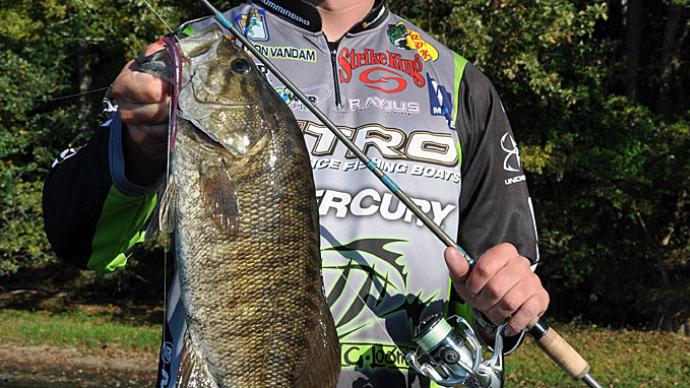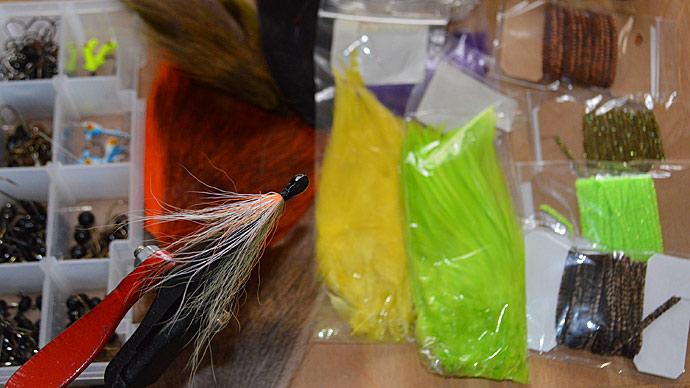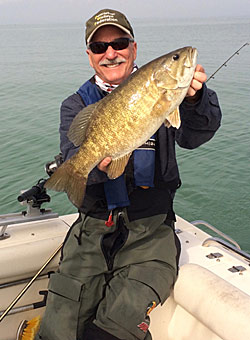
A lead-head jig is a perfect tool for delivering some of the best lures for smallmouth bass, but no one jig can do it all. Jigs are shaped differently to perform in different situations. Jigs are shaped to swim and glide through the water, pound the bottom, bust through weeds and grass, and present Senkos and wacky worms. To take advantage of jigs' versatility, you need to know what jig works best and when.
Art Ferguson III has gained a well-deserved reputation as one of the top smallmouth guides on Lake St. Clair in Michigan. But Ferguson has proved he can hold his own just about anywhere bass swim. He’s been a full-time guide since 1990 and has been a four-time qualifier for the Bassmaster Classic via the Bassmaster Northern Open circuit, the Elite Top 150, and the Federation twice. He has also qualified four times for the FLW Championship. Although smallies are a favorite, Ferguson has proven he can catch largemouths too, and now guides clients in Florida for part of the year.
Ferguson was a cerebral angler, thinking about how he could make one of his favorite and most productive lures on Lake St. Clair, a tube jig, fish better. He concluded that a tube jig spiraled down when it hit the water because the weight on the jig hook was not distributed evenly. Ideally, Ferguson wanted the jig to fall straight down and then swim straight on the retrieve or when being manipulated. Ferguson reasoned that most of what Great Lakes smallmouths eat- perch, shiners, and gobies- swam in a straight line when fleeing. About the only time a spiraling action would be suitable for a tube jig is when you were trying to imitate a dying shad, which doesn’t happen much on the Great Lakes. A spiraling jig also caused more line twists.
Ferguson set out to design a tube jig that was better balanced with a 90-degree line tie made on smaller 2/0 and 3/0 hooks. At the time, there was a jig like that available. Ferguson reasoned the smaller hooks would cause fewer line tangles, result in fewer snags and produce fewer deeply hooked fish. The hooks also worked perfectly with the 3-1/2- to 4-inch tubes he often fished.
The new jig performed so well that his clients and other pro anglers were clamoring for the jigs, so Ferguson started Provider Tackle in 2005. Initially, Provider Tackle just offered tube jigs and a variety of tubes in different custom colors, but now the company makes a host of jig designs, drop shot weights, umbrella rigs, skirts, beads, swivels, and riggin’ weights that discriminating bass anglers are searching for to practice techniques that are needed to catch bass, and smallmouth bass in particular consistently.
Tube Jig - The tube jig is Provider Tackle’s most popular design and comes in seven different weights, with ¼-ounce being the most popular. “Performance Series" Tube Jig gives a natural action to your tubes,” Ferguson said.
“The weight is distributed properly on the hook, so the tube falls vertically instead of spiraling down. Doing so allows the jig to assume a nose-down attitude that imitates a more life-like posture. When rigged properly, the bait will also have a streamlined swimming action on the retrieve, which helps reduce line twist and makes the bait look like natural forage.”
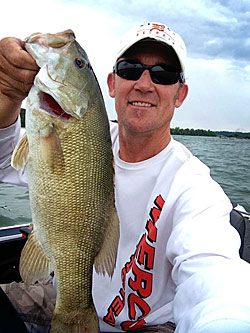
The tube jigs perfectly match the custom tube baits Provider Tackle offers. The garlic and baitfish enhanced tubes are available in a 3-1/2 inch “bite-sized” version, a 3-1/2 “slim” version, and a standard 4-inch tube.
“These 3.5" slimmer style tubes give you a more compact look than our popular 4-inch version," he said. “The tubes are perfect to match the hatch of most any size forage. Slim tubes are very popular for ultra-clear water when using lighter weights and are awesome for bed and sight fishing.”
Although tube jigs are a go-to bait for smallmouth fishing, they are not the only jig used for catching brown bass. Anglers must educate themselves about other jigs and learn how to fish them if they are prepared for every situation.
Finesse jig -“Finesse jigs are a great alternative when you need a smaller bait and a stealthy presentation,” Ferguson advised. “Finesse jigs excel in clear water but can be very effective in the stained and colored water. The coned-shaped head is perfect for throwing around rock, riprap, sea walls, wood, laydowns, etc. Provider Tackle’s Redemption Series Finesse Jig comes with a skirt, and anglers traditionally add a trailer of some kind.
“Finesse jigs are ideally suited to fish around rocks and hard-bottomed areas. Finesse jigs are not used a lot on the Great Lakes and are probably best suited to reservoirs, but even here, finesse jigs have their day.”
Ferguson added that his clients caught 15 smallmouth bass on finesse jigs that day when nothing else seemed to work.
Provider Tackle’s finesse jigs come with a 4/0 hook and are best fished on spinning tackle and 10- or 12-pound test line. The jig comes with a 60-degree line tie that facilitates a swimming presentation that excels in spring and fall. The jig allows for a smaller profile and comes in ¼- to 3/8-ounce versions with a double barbed keeper on the hook shank.
Football Jig -“Football jigs are used mainly in cold water and are good for covering water and minimizing snags when fishing rocks, boulders, and deep structures,” shared Ferguson. Provider’s "Rapture Series" Football Jig is a custom-molded jig that comes in three sizes (1/2, 5/8, 3/4 oz.) and several muted colors intended to imitate natural presentations of crawfish, baitfish, and other forage. The strong 60-degree line tie and Mustad 4/0 hook are the perfect sizes for specific deep-water applications where you need to get down and not get snagged. The football jigs are available in the 5/0 “big bass” hook option.
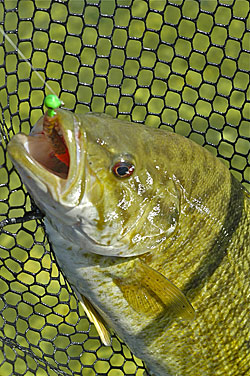
The Rapture Series football-shaped heads prevent the jig from getting wedged between rocks and crevices when dragging in 30 to 40 feet of water yet maintaining contact with the bottom. Football jigs come in skirted and unskirted versions. Ferguson said he usually adds a Yamato Hula Grub to the jig to imitate gobies and crawfish.
Pitching Jig -“You don’t think smallmouth when you think pitching jigs, “ joked Ferguson. But they are still an option in your smallmouth arsenal. Provider’s Master Series Pitching Jigs are designed for heavy cover with a 60-degree line tie and an extra-stronger hook with an Arkie-style head that punches through vegetative jungles. The stout hook facilitates winching lunker bass out of heavy cover. The skirt fans out and twitches seductively, triggering bass to eat, especially when you add twin-tailed plastics or creatures.
Shakey Head Jigs - “The "Survivor Series" Shakey Head jigs are designed with an awesome 4/0 Owner hook that is strong yet small in diameter for superior penetration through your worm and into the fish's lip,” said Ferguson. “A firm bait holder and a 60- degree bend on the eye make this as good as any shakey head on the market. The Survivor Series shakey head comes in three sizes and many colors to choose from, all hand-painted in the USA.”
Finesse worms and shaky heads go hand in hand. “Finesse worms are great for spring sight fishing and are ideal for vertical fishing in clear, cold water and rocks in situations like you’d find on Table Rock. They are a must-have lure anywhere you’re fishing for smallmouths. They’re very versatile. You can hop, drag or swim them, and they’re relatively snag-free.” The 1/16- 3/16 jigs are designed for light 6- to 10-pound test lines and delicate presentations.
Swim Jigs -“The Cut 'n Edge Series swim jig has it all,” declared Ferguson. “A cutting edge on the face of the jig allows it to pull through thick grass where a swim jig is designed to go. 3-D eyes, chip-proof paint with flake for extra flash, awesome skirt colors, and a sharp Owner Super Strong 4/0 hook with a 30-degree bend allows you to fish this jig in the thickest grass or dense wood. It is tough to get this bait hung up. It’s ideal for places like the Potomac and Mississippi rivers, with massive grass beds. Add a swim bait or craw-type trailer, and hold on!”
Wacky Rig Jigs
“The “Descending Series” Whacky Rig jig is another tool in your finesse fishing arsenal,” said Ferguson. “The wacky rig jig is designed to help you control the fall and bring out the best action of your wacky-rigged baits. “The jig is available in three sizes and many color options. The head is perfectly balanced to help enhance that crazy, wacky jig-head action. The light wire stainless steel weed guard (optional) helps prevent snags while not inhibiting plant-your-feet hook sets.”
The wacky jig lends itself to open water situations where you toss a Senko, 4- to a 5-inch worm or dead sticking.
A carpenter has more than one saw or hammer. And a smallmouth angler certainly needs more than one jig style.



